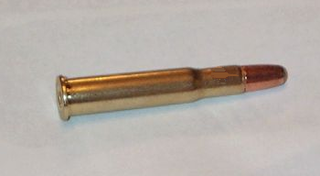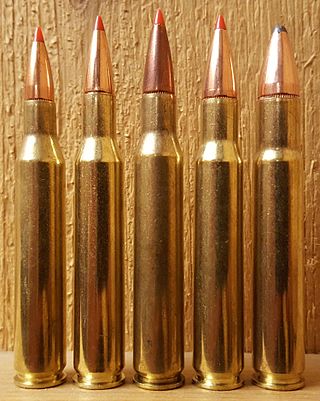Related Research Articles
Winchester rifle is a comprehensive term describing a series of lever action repeating rifles manufactured by the Winchester Repeating Arms Company. Developed from the 1860 Henry rifle, Winchester rifles were among the earliest repeaters. The Model 1873 was particularly successful, being marketed by the manufacturer as "The Gun That Won the West".

Weatherby, Inc. is an American gun manufacturer founded in 1945 by Roy Weatherby. The company is best known for its high-powered magnum cartridges, such as the .257 Weatherby Magnum, .270 Weatherby Magnum, .300 Weatherby Magnum, .340 Weatherby Magnum and the .460 Weatherby Magnum. The company's headquarters is based in Sheridan, Wyoming.
The Winchester Repeating Arms Company was a prominent American manufacturer of repeating firearms and ammunition. The firm was established in 1866 by Oliver Winchester and was located in New Haven, Connecticut. The firm went into receivership in 1931 and was bought by the Western Cartridge Company, a forerunner of the Olin Corporation. The Winchester brand name is still owned by the Olin Corporation, which makes ammunition under that name. The Winchester name is also used under license for firearms produced by two subsidiaries of the Herstal Group – FN Herstal of Belgium and the Browning Arms Company of Ogden, Utah.
Marlin Firearms Co. is an American manufacturer of semi-automatic, lever-action, and bolt-action rifles. In the past, the company, now based in Madison, North Carolina, and formerly based in North Haven, Connecticut, made shotguns, derringers, and revolvers. Marlin owned the firearm manufacturer H&R Firearms. In 2007, Remington Arms, part of the Remington Outdoor Company, acquired Marlin Firearms. Remington produced Marlin-brand firearms at its Kentucky and New York manufacturing facilities. In 2020, Sturm, Ruger & Co. bought the Marlin business from bankrupt Remington Outdoor Company.
Thompson/Center Arms was an American firearms company based in Springfield, Massachusetts. The company was best known for its line of interchangeable-barrel, single-shot pistols and rifles. Thompson/Center also manufactures muzzle-loading rifles and was credited with creating the resurgence of their use in the 1970s.

The .30-30 Winchester cartridge was first marketed for the Winchester Model 1894 lever-action rifle in 1895. The .30-30, as it is most commonly known, along with the .25-35 Winchester, was offered that year as the United States' first small-bore sporting rifle cartridges designed for smokeless powder. Since its introduction, it has been surpassed by many cartridges in the long-range shooting attributes of speed, energy, and trajectory, yet remains in widespread use because of its practical effectiveness in forested hunting situations.

H&R 1871, LLC, or more commonly known as Harrington & Richardson, is an American brand of firearms and a subsidiary of JJE Capital Holdings. H&R ceased independent production February 27, 2015.
The Marlin Model 336 is a lever-action rifle and carbine made by Marlin Firearms. Since its introduction in 1948, it has been offered in a number of different calibers and barrel lengths, but is commonly chambered in .30-30 Winchester or .35 Remington, using a 20- or 24-inch barrel. Currently, the model with a 24-inch barrel is only available in .30-30 Winchester. The Model 336 is now back in production as of March 27, 2023.
The Winchester Model 1894 rifle is a lever-action repeating rifle that became one of the most famous and popular hunting rifles of all time. It was designed by John Browning in 1894 and originally chambered to fire two metallic black powder cartridges, the .32-40 Winchester and .38-55 Winchester. It was the first rifle to chamber the smokeless powder round, the .30 WCF in 1895. In 1901, Winchester created the new .32 Winchester Special caliber with production of rifles starting in 1902.

The Ruger No. 1 is a single-shot rifle with a Farquharson-style hammerless falling-block action, introduced and manufactured by Sturm, Ruger & Co. since 1967. An underlever lowers the breechblock to allow ammunition loading and also cocks the rifle. Lenard Brownell, commenting on his work at Ruger, said of the No. 1: "There was never any question about the strength of the action. I remember, in testing it, how much trouble I had trying to tear it up. In fact, I never did manage to blow one apart."

The Winchester Model 1892 was a lever-action repeating rifle designed by John Browning as a smaller, lighter version of his large-frame Model 1886, and which replaced the Model 1873 as the company's lever-action for pistol-caliber rounds such as the .44-40.

The Browning BLR is a lever-action rifle manufactured for Browning Arms Company by Miroku Firearms in Japan. It comes in many different variations and is chambered in numerous calibers from small and fast to the large Magnum rounds, and the large bore .450 Marlin.
The Remington Model 798 is a bolt-action rifle that was sold by Remington Arms from 2006 until 2008. The gun was made as a hunting rifle. It is composed of an imported Zastava Arms barreled action assembled with a laminated stock after import to the United States. It is based on a Mauser 98 action. It is chambered for .243 Winchester, .308 Winchester, .30-06 Springfield, .270 Winchester, 7mm Remington.Magnum, .300 Winchester.Magnum, .375 H&H Magnum and .458 Winchester Magnum It is drilled and tapped for scope mounts. It can have a barrel length of 22, 24 or 26 inches. It weighs 7 pounds, and has a brown laminated stock. The standard variant costs $599, and the Magnum versions can cost anything between $638 and $839. This is an all-steel, controlled-feed action using a flat-bottom receiver with an integral recoil lug, one-piece bolt with dual locking lugs plus a third safety lug and a bolt guide, full-length extractor, solid steel one-piece bottom iron/magazine box/trigger guard, hinged magazine floor plate, and all of the usual Mauser 98 deluxe features.
Remington Arms Model 600 was a push feed bolt-action rifle produced by Remington Arms from 1964 to 1968. While it is commonly believed that production ended in 1967, according to Remington representatives records indicate that it actually ended in 1968. This Model was the precursor to the Model 660 ; the Model Mohawk 600 ; and the Model 673.
The Winchester Hotchkiss was a bolt-action repeating rifle patented by Benjamin B. Hotchkiss in 1876 and produced by the Winchester Repeating Arms Company and Springfield Armory from 1878. The Hotchkiss, like most early bolt-actions, had a single rear locking lug integral with the bolt handle, but was unique in feeding multiple rounds from a tubular buttstock magazine similar to the Spencer rifle. The .45-70 Hotchkiss was acquired in limited numbers by the US Navy as the M1879, and by the US Army and several state militias as the M1883, making it the first center-fire bolt-action repeater to be adopted by any major military.

.30-06 Springfield wildcat cartridges are cartridges developed from a 30-06 Springfield "parent cartridge" through narrowing or widening the cartridge neck to fit a smaller or larger bullet in an attempt to improve performance in specific areas. Such wildcat cartridges are not standardized with recognized small arms standardization bodies like the SAAMI and the CIP.
The Winchester Model 100 is a semi-automatic rifle manufactured by Winchester Repeating Arms Company. It was first introduced in 1961, and was manufactured until 1973. A total of approximately 262,838 were manufactured. Variants of the weapon are capable of firing a .308, .243, or .284 Winchester cartridge. The barrel is 22 inches (56 cm) long. It was also available in a Carbine with a 19" barrel. The rifle weighs 7.5 pounds (3.4 kg).
The BSA CF2 is a rifle manufactured by the Birmingham Small Arms Company (BSA).
References
- ↑ "Winchester Western - 1967 Sporting Arms and Ammunition" (PDF). Archived from the original (PDF) on 2016-08-08. Retrieved 2023-10-06.
- ↑ "American Rifleman | The Model 70 Story: A Classic Advanced". americanrifleman.org. Retrieved 2016-11-13.
- ↑ pg156-157 Henshaw, Thomas., The History of Wichester Firearms 1886–1992, Academic Learning Company LLC., 1993, ISBN 0832905038.
- ↑ pg156 Henshaw, Thomas., The History of Wichester Firearms 1886–1992, Academic Learning Company LLC., 1993, ISBN 0832905038.
- ↑ pg156 Henshaw, Thomas., The History of Wichester Firearms 1886–1992, Academic Learning Company LLC., 1993, ISBN 0832905038.
- ↑ pg156 Henshaw, Thomas., The History of Wichester Firearms 1886–1992, Academic Learning Company LLC., 1993, ISBN 0832905038.
- ↑ pg156 Henshaw, Thomas., The History of Wichester Firearms 1886–1992, Academic Learning Company LLC., 1993, ISBN 0832905038.
- Henshaw, Thomas., The History of Wichester Firearms 1886–1992, Academic Learning Company LLC., 1993, ISBN 0832905038.